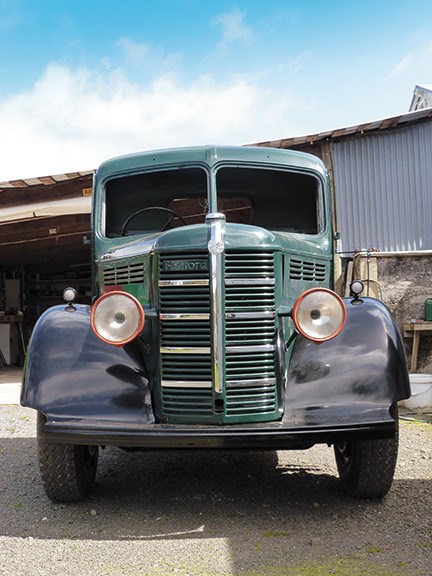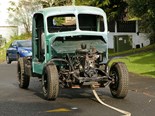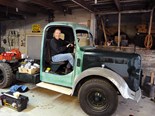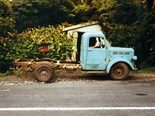K Bedford restoration project: part 5
.jpg) The 750 tyres on 16 inch rims is an original feature on what were known as Beford "K Specials".
The 750 tyres on 16 inch rims is an original feature on what were known as Beford "K Specials".
.jpg)


.jpg) 1981 delivering 1.5 cubic metres of scoria in the Waitakere Ranges.
1981 delivering 1.5 cubic metres of scoria in the Waitakere Ranges.
.jpg)
.jpg) Driver's door awaiting some welding.
Driver's door awaiting some welding.
.jpg)
.jpg) One way or another, we'll eventually make sense of how the loom pieces together.
One way or another, we'll eventually make sense of how the loom pieces together.
.jpg)
.jpg)
|
|
The 750 tyres on 16 inch rims is an original feature on what were known as Beford "K Specials".
|

|
.jpg)
|
|
1981 delivering 1.5 cubic metres of scoria in the Waitakere Ranges.
|
.jpg)
|
|
Driver's door awaiting some welding.
|
.jpg)
|
|
One way or another, we'll eventually make sense of how the loom pieces together.
|
A saying used by an old acquaintance, which is relevant to my mission to restore a K Bedford truck, went something like this: "Life is like golf, sometimes you have to go backwards before you can go forwards."
Well I don't know the first thing about golf, but events of the last month have certainly taught me that the principle really does apply to the field of vehicle restoration. Let me explain...
One month ago, the restoration was cracking along at a pretty decent pace – the mudguards had been fitted, the grille and bonnet were in place, and what we had sitting in my mate Murray's shed looked like a fairly complete K Bedford truck minus deck.
However, that was about to come to a halt (I was going to say 'a grinding halt' – but that'd probably be over-dramatising the situation).
Project timeline
In case you've just come onboard with the story – or if you've missed an issue or two – I should fill in a few gaps in the story by inserting the following timeline:
- 1979 – I purchased the truck
- 1981 – Truck goes off road at Christmas for rust repairs
- 1990s – Rust repairs carried out to cab
- 1990s/2000s – Truck shed-stored at several locations
- Recent times – (April this year to be precise) final push to complete
Going backwards to go forwards
In last month's issue, I said the doors were proving to be a bit of a problem, where we were fixing one problem only to be confronted with another. For instance, we'd find a crack on the inside panel, repair it, refit the door, make an adjustment or two and a crack would appear somewhere on an outer panel.
It was getting to the stage where I was getting embarrassed to go back to our engineer mate, Dean to ask him to weld up another crack. Note to self: Get A into G and go to welding classes.
At one stage we were even considering finding another pair of doors until we came to the stark realisation that with all the various processes involved, such as stripping work and countless hours of hard slog now behind us we were well and truly past the point of no return.
The good news is that the left door now fits almost perfectly and will require only some prep work before I put on that all important coat of etch primer.
It's also true that we have got a set of running boards permanently attached to the mudguards and the only real reason the truck looks less complete than it was a month ago is because we've removed the bonnet and side panels (a ten-minute job to replace) in order to get at fitting the wiring loom which arrived from England a couple of weeks ago.
A new/old fuel tank
I guess that writing about all of this is somewhat therapeutic as I've only now realised that things aren't nearly half as bad as I thought they were when I started writing this month's contribution. 
Back in the 1990s, I'd thrown a coat of paint on the chassis and the fuel tank that was still attached to it and while it looked good enough at the time, it really looked quite shabby up against the rest of the truck that was newly painted, so a decision was made to remove it and give it a bit of a pretty-up.
Even though the truck has been stored in a shed all these years, the tank mounts and the chassis behind it really needed some love and attention in order to be in keeping with the rest of the restoration.
So off it came, only to reveal that it was full of holes as if someone had punctured it many times with a fork.
Not to worry, help was at hand from the strangest quarters. I mentioned a couple of issues ago that I'd been on a road trip to the bottom of the South Island to rescue a couple of old FG Morris trucks.
Everyone who knows me and had suspected I had rocks in my head had the thought confirmed when I arrive back in Auckland with these beautiful pieces of British engineering on the back of an eight-wheel transporter.
Even I was left doubting any vestige of sanity I ever thought I had. Anyway, the upshot of it all was the smaller of the two trucks, the one I hope will wind up being restored, was fitted with a Bedford fuel tank that is in far better condition. Not perfect, but restorable.
The tank is currently going through the stripping process before going on to have a few minor holes filled – thank you, Mr Morris.
The little FGK30 Morris won't miss out in the end, as the larger truck which is actually an Austin, has quite a good genuine BMC tank which I can use when restoration time comes around.
Wiring loom
The wiring loom from England I was telling you about arrived neatly packaged and is a sight to behold, resplendent in its colourful sewn sheathing. It consists of no less than nine component parts, all of which fell into place, neatly with all terminations landing in just the right spot.
Did I say all pieces fit? Well they do, all except for the largest piece, which connects to the instrument panel and is supposed to follow a dual-pathway to the front of the truck. We've tried to route it every which way and do you think we can make it fit?
One thing's for sure, we won't be able to give you an answer in this month's issue – hopefully it'll be in the next.
It hasn't been the most exciting month of Bedford restoration but there are at least some good things bubbling along in the background.
Murray's found a K with the original wiring – hopefully that'll give us some answers to our wiring woes. The instruments are being rebuilt at Robinsons Instruments in Onehunga – the tank of course is underway and Jeremy Tagg from Bespoke Auto Glass is waiting for the doors to be finished before starting on that side of the project.
And now for this month's restoration advice: write about your project as you go, and you may well find you've done more than you think.
For the latest news and reviews, subscribe to Deals On Wheels magazine here.
Keep up to date in the industry by signing up to Deals on Wheels' free newsletter or liking us on Facebook.









.jpg)






